Carol Hurst's Children's Literature Newsletter
Winter 1999. Page 3.
Written by Carol Hurst and Rebecca Otis.
|
This issue is sponsored by Teaching K-8 Magazine. Subscribe now for only $12.00 |
Book Reviews

First off we have the recent Newbury Award winner. With Holes (Farrar, 1998 ISBN 0374332657. Hardcover), Louis Sachar has brought us to the bizarre world of a detention camp run by one of the most intriguing villains in children's literature. Camp Green Lake is neither a camp nor a lake although it once was both. Now it's a barren desert area and a prison camp for delinquent teenage boys. A boy with a palindrome for a name, Stanley Yelnats, was tried and convicted of a crime he did not commit and was given the choice of Camp Green Lake or prison. This is just the latest in a series of misfortunes that have befallen generations of the Yelnats family since being cursed by an old woman in their native country.
The warden of Camp Green Lake, a woman with deadly, long fingernails, has set the task and the rules for the boys. Each day, each boy must dig a hole in the parched desert five feet deep and five feet square. When an exhausted, parched and aching Stanley comes back to the barracks far later than the others having completed his first hole, he is told that the next day's hole will be harder. The same assessment is made every day and it is always true as the insane, exhausting task continues. The boys are told where to dig and given a meager supply of water and food in spite of the awful heat.
Stanley grows stronger, of course, and even acquires a nickname "Caveman". Gradually he gains some respect from his fellow inmates. When one runs away into the desert where there is no source of water, Stanley goes after him, guided by his memory of a tale told by his ancestors. The two survive and even come back to bring down the whole system.
The reason for the digging becomes apparent as this absurd and often very funny tale continues. The combination of survival adventure story and tongue-in-cheek action keeps the reader turning pages while being careful not to miss a detail. Kids who have read the book will have lots to talk about and teachers will appreciate the many symbols in the plot - holes are everywhere including in the logic. Coincidences stretch belief and give the book a fairy tale quality causing many to compare this work with that of Kurt Vonnegut. Others will be reminded of Catch 22 or The Princess Bride. The book is not difficult to read but the humor and the action make it tailor-made for kids from sixth grade up.

Mordicai Gerstein's The Wild Boy (Farrar, 1998 ISBN 0374384312. Hardcover.) is the story of a feral child captured in France in 1800. Gerstein concentrates on the behavior of the wild boy both before and after his capture. Because he was such an anomaly, never acquiring the ability to speak, we cannot know his thoughts and Gerstein doesn't attempt to tell us what they are. He makes the contrast between the child's wild, carefree life where he ran about naked enjoying it all and his life after capture when he was examined by experts and then pretty much abandoned in a locked room. Thought to be retarded, he was taken home by one of the scientists, Jean Marc-Itard. He named the boy Victor and the child responded to the love and acceptance exuded by Dr. Itard and his housekeeper. Victor was able to learn to write a bit but, because he was deprived of language in his early years, he never learned to talk. Children from about second grade up should be intrigued by this mysterious and unfortunate child and maybe go on to read accounts of the fate of other feral children. Also by Mordicai Gerstein.
Helen Griffith's Alex and the Cat has been reissued (Greenwillow, 1997 ISBN 0688152414. Library Binding.). It's been out of print too long and now has new illustrations by Sonia Lamut. This very accessible book has such wonderful sly humor that you won't want to restrict its use to beginning readers. Within seven short chapters we get a glimpse of a gentle, warm friendship between two traditional enemies and some insight into the essential differences between cats and dogs. Alex is exuberant, emotional and a bit silly. The cat (we never know its given name) is sedate, self-contained and wryly humorous. We'll have to hope that a reissue of the other two Alex and the Cat books aren't far behind. In the meantime, your kids might like to find books with other unlikely or similarly gentle friendships.
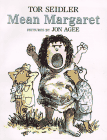
When I saw that Tor Seidler's Mean Margaret with pictures by Jon Agee (HarperCollins, 1997 ISBN 0062050907. Hardcover.) was one of five finalists for the National Book Award in '98, I'll admit I was surprised. Of course, I hadn't read it yet but the cover doesn't look serious enough for such an award. Then I read the book. It is delightful and can lead in all sorts of directions. You've heard that it takes a village to raise a child. In this case it takes a cave -- full of kindly but disparate creatures. The main character is a woodchuck named Fred who lives a solitary bachelor's existence at the beginning of the book. He's fastidious and distinctly unsociable. Then he falls in love. Phoebe has been helping her sister Babette raise her unruly brood of young woodchucks when she meets Fred and the two soon marry and settle down to a warmer but still peaceful life in Fred's burrow. Then a noisy, bratty human baby is literally dropped into their world and as we mothers know, the care and feeding of even a pleasant child is quite an undertaking. Margaret is anything but pleasant. She soon demolishes their burrow and her constant demands for food soon drive Phoebe and Fred into a cave inhabited by many animal friends. It's a cooperate effort indeed and it tries all their patience to keep Margaret nourished. This one's fun. Read it aloud to your second, third and fourth graders after you've chortled through it yourself.
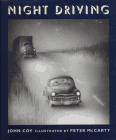
Nothing very much happens in Night Driving by John Coy with illustrations by Peter McCarty (Holt, 1997 ISBN 0805029311. Hardcover.). The book is done in black and white, just perfect for the nighttime trip which, looking at the vehicles, must take place in the 1940s. It's a simple story of a boy and his father driving through the night together in order to get to their campsite in the mountains by morning. As they travel, they talk, sing and tell stories. They stop to change a flat, to get gas, to use a roadside outhouse and to get food at a diner. In such places they see and hear other nighttime travelers. It's a quiet evocative book as any night drive should be. Don't assume it's just for the younger crowd. Show it to anybody who grew up in the 40s and be prepared to hear a lot of songs and stories.
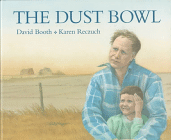
David Booth's picture book The Dust Bowl (Kids Can Press, 1997 ISBN 1550742957. Hardcover.) with illustrations by Karen Reczuch is set in the present but the memories are from the thirties. The current drought has lasted a long time and the boy's father is angry and discouraged. The grandfather, however, remembers a longer drought and a harder time. He tells about the dust bowl of the thirties during which many farmers abandoned their homes and set off to escape the dust and the poverty. He and his family, however, stuck it out and, eventually, the rains came and the dust settled and the crops grew again. It wasn't the end of the bad times or the good times. This is a book about hope. (See also Out of the Dust which is a short novel about the Dust Bowl.)
What About Emma? (Orchard, 1997 ISBN 0531095347. Hardcover.) by Ken Rush tells of a little girl and her love for a cow. Her family has a large herd but Emma is our narrator's favorite. Now the father and mother have sad news. They must sell the herd if they are to keep the farm. They'll keep some chickens, ducks and a few goats but the cows must go. Emma will have a calf soon and the children plead to be allowed to keep Emma until the calf is born when they can sell both. The little girl has made a pet of Emma, even riding her back to the barn sometimes. When Emma is about to give birth, she heads off into a snowstorm in the middle of the night. Only that trick the little girl taught her can save Emma.

David Macaulay has given us so many wonderful books, it's always a pleasure to pick up a new one. His work seems to fall into two categories, the zany and the architectural. In his latest book, Rome Antics (Houghton, 1997 ISBN 0395822793. Hardcover) gives us a hint of the zany and lots of the wonderful architectural information. Don't miss the title pun or you may miss some of the action which starts before the title page as a young woman releases a homing pigeon along a road to Rome (where all roads lead). From that point on we follow a red line indicating the pigeon's flight to and through Rome. Who but Macaulay would know and love the city so intimately and then think of giving us a pigeon's eye view of it all. He nicely captures some of the trivia about Rome -- the cats, the pigeons and the tourists. He shows the ancient city as a place of modern life. People use cell phones. They shake dry mops from beautiful Doric windows. The information in those illustrations is wonderful and quite comprehensive. The playfulness of it all is a delight. The ending is sweet as all rome-antic endings should be. When you and the kids have perused the book and the information on the buildings and monuments that Macaulay appends to it, visit http://www.roma2000.it/zmonum2.html#Monumenti on the web. Here many of the sites from Rome Antics are shown and further history given. They are also located on the map of Rome. Then give the kids cameras and camcorders and head for your own downtown. Make pigeon pictures of your town from every perspective and look for the same elements of architecture there. You'll find them. See also Black and White by David Macaulay and our article on Buildings and Architecture in kids books.
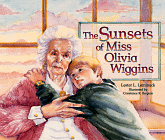
The Sunsets of Miss Olivia Wiggins (Peachtree, 1998 ISBN 1561451398. Hardcover) by Lester Laminack with illustrations by Constance Bergum, was written by Lester Laminack is a tender book. Miss Olivia sits in a nursing home with her hands folded on her lap. She seems to see and hear nothing, not even when her daughter and great-grandson talk directly to her. Her face, however, is turned toward the sunset and she is remembering. As we share snippets from her past we get glimpses of the strong, loving woman she was before Alzheimer's disease ravaged her mind. She doesn't talk or react in any way. Her great-grandson, however, continues to relate to Miss Olivia and he sees, as we do, the twitch of a smile as he hugs her goodbye. Writing about Alzheimer's in a book for young children is a touchy matter. One step too far in one direction and you get sentimentality. Too far in the other direction gives such hopelessness that it's too bleak a picture. Laminack walks that line carefully and does a sensitive portrayal. This is a book to treasure.
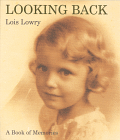
Looking Back: A Book of Memories by Lois Lowry (Houghton, 1998 ISBN 039589543X. Hardcover.) is not a typical author's autobiography. It doesn't start with her birth and end with her life today in Cambridge. It isn't the least bit chronological but we know a lot about Lois and about the reach between generations when we've read it. Looking Back is not just for children either. It's for anyone who has read and loved her novels. Through these wonderful pictures, some taken by Lois's great-aunt, some by her father and some by the author herself, we get glimpses of the stories of her life. Each chapter is introduced with a quote from one of her books. We then get a sense of sitting beside Lois Lowry as she goes through the family photograph album. The juxtaposition of those photographs is inspired. We see portraits of her mother and of herself at the same age and the similarities of pose and expression is eerie. Some of the photos and stories elicit tears and others, chuckles or outright laughter. The stories vary in length and in import. It's wonderful to see the house on Autumn Street (all right, so it was really College Street) and see Tatie and Charles and the great-aunts and Noah in our mind's eye even if the camera missed them. The photographs and the stories combine to give us an intimate portrait of the artist, as a child, a young mother, a grandmother and, always, as a writer. So that's where she gets her ideas!
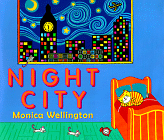
Night City by Monica Wellington (Dutton, 1998 ISBN 0525459480. Hardcover.) is a nice addition to the social studies picture books because it deals with time, night, lots of occupations and the city. It starts with you, a child, settling down to go to bed at quarter of seven. (That's where you have to stretch credulity a bit.) From then on, each page represents the turn of the hour as we go through the night and into the morning. In the process, we are made aware of a lot of people for whom bedtime doesn't come until morning. Dancers do a last minute rehearsal before a theater performance. Weary travelers check into a hotel and several hotel-related occupations are mentioned. Office buildings are cleaned. An artist paints her vision of the city's night skyline. Firemen respond to and extinguish a fire. A watchman makes his rounds in the art museum. And so it goes through the night. The illustrations are perfect - precise, imaginative and quite lovely, particularly the one with the lighted bridge.

Richard Peck has given us another winner. Strays Like Us (Dial, 1998 ISBN 0803722915. Hardcover.) is narrated by Molly who's been dumped by her mother again. Although we don't get all the details, we know that it's not the first time and that life with her mother has been difficult. There are oblique references to homeless shelters and a drug problem. Now Molly is to stay with her Great-Aunt Fay, a practical nurse. Molly resists making friends because she knows that her mother, whom she calls Debbie, will be back for her any minute and they'll be off again.
Next door, Will is also a stray. He's been dumped with his grandmother and it is believed that his father is in jail. Will reaches out to Molly and gradually a friendship develops. Will's father, it turns out is not in jail but in the house, dying of AIDS. When the truth comes out, Will is rejected by the few other friends he's made. He's not surprised. He knew that's what would happen. It's the end of the basketball team for him as well. Molly, in the meantime, has established a tentative friendship with Tracy Pringle, a very privileged and protected child. That friendship is broken off as well, by Mrs. Pringle. Tracy's end is tragic, however. There are many secrets in this small town and Molly uncovers many of them. Her mother doesn't come. Aunt Fay turns out to be a wonderful, strong woman and she and Molly will make it. So will Will. This is a fast moving, insightful novel that blows the concept of safety in the suburbs. (See related Richard Peck link below.)

To read any account of the Holocaust is always a terrifying experience. The affront to humanity, the overwhelming cruelty, the tragedy of all those lives lost to the world and to their families, and the guilt that we did nothing to help, all add up to despair. Then there's the fact that some survived the hell and went on to become productive citizens and despair is replaced by awe. I always pick up a biographical Holocaust book with mixed feelings. I know the tale will be gruesome and yet, of course, I look for hope. There's hope from the very beginning of the autobiography No Pretty Pictures: A Child of War (Greenwillow, 1998 ISBN 0688159354. Hardcover.) because we know that the author survived to become the creator of many beautiful, funny and clever picture books.
Anita Lobel's upper middle class childhood in Krakow changed from the moment the soldiers goose-stepped into town, an event she and her family witnessed from their balcony. Almost immediately, her father went into hiding, kissing her goodbye as she slept. She wasn't to see him again for seven years. With her Catholic nanny, Anita and her brother lived furtive lives, hiding in remote villages, begging neighbors for bread and milk, hiding in the Krakow ghetto between floor boards as the Nazis searched the house and then into a Benedictine shelter. Her brother was disguised as a girl so that his circumcision would not give them away. Anita was taught to loathe her Semitic features and her Jewishness. Imagine what that must have done to those kids. They were too busy surviving to dwell on it however.
For five and a half years they managed to stay out of the Nazi round-up and then, suddenly the Nazis came. Shuttled from one concentration camp to another sometimes on foot, sometimes in cattle cars, Anita and her brother hid in corners, surviving on thin cabbage soup. At one point only her quick thinking placed them in the line leading away from the furnaces rather than the other.
Anita Lobel keeps us with her as she gives us a child's eye view of the horrors. It rings true at every step. We spend a few chapters with her after the war when her family was reunited in Sweden. She talks about having yearned for so long to have parents to care for her yet when they came at last Anita, with her knowledge of Swedish and the culture, became the adult-child caring for her parents. Anita Lobel's discovery of watercolors when at last she could attend a real school for the first time in her life, her first efforts praised by the art teacher is a source of joy for the child and for us, the readers, for we know where that discovery led. This is a beautifully written, insightful book. It makes her picture books even more beautiful and the Holocaust even more personal.
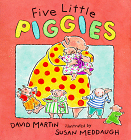
David Martin and Susan Meddaugh have combined efforts to give the child and the adult who shares the book a chuckle in Five Little Piggies (Candlewick, 1998 ISBN 1564029182. Library Binding). It's based on the rhyme every parent knows. We even know how to wiggle each toe as we do it although none of us can remember who taught us how to do it. You'll never be able to do it again without giggling about these tiny tales. The one that went to market does so in order to get eggs and milk for her mother. She mixes the short list up a bit but gets it straight in the end. The piggie that stays home does so at the suggestion of his mother after a morning filled with small accidents and he and his mother have a wonderful time. The little piggie who has roast beef, (you've got to admit that's an unlikely choice of diet for a pig), orders it only to find that it isn't fit for a pig until he's made it into slops. The "none" that the fourth little piggie has turns out to be a good thing. What he has none of is an illness that causes spots as his sick brothers and sisters have. The fifth little piggie crying "wee, wee, wee" does so all the way home where he rushes to the bathroom.
Related Areas of Carol Hurst's Children's Literature Site
- Richard Peck, Featured Author
![]()
Go to Next Section of Newsletter, Featured Author: Kathryn Lasky.
Return to Table of Contents of the Newsletter.
Advertisement:
Advertisement:
Advertisement:

